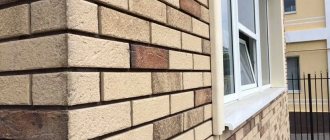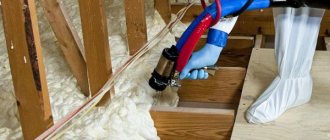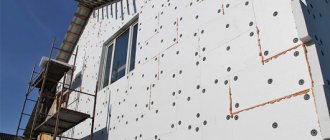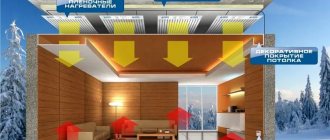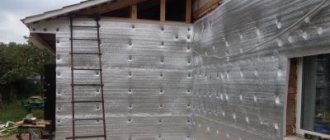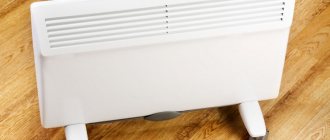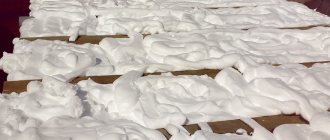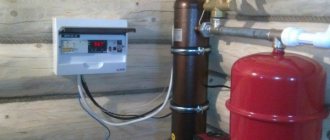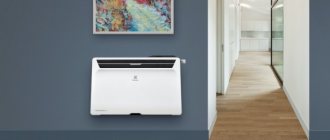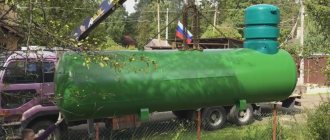Hi all! Owners of private houses are very concerned about the appearance of the building. It should not only be attractive, but also protect the interior space from dampness, cold and other negative factors. Thermal panels for exterior decoration of the house can help in this regard.
Today I will introduce you to this material, its features, strengths and weaknesses. Let's all take a tour together.
If you are ready, then let's begin. You can stock up on some goodies or make yourself a cup of hot drink. It's still autumn.
What it is
First you need to understand what thermal panels for exterior decoration of a house are, and why they are used at all.
This is a facade finishing material that performs 2 functions simultaneously. This is giving the building a complete appearance, as well as its insulation.
The functionality of thermal panels allows you to save time and money on finishing and insulation. Installation is quite easy.
The main properties of thermal panels include:
- the ability to imitate brick, stone masonry or wood cladding;
- increasing the thermal insulation, waterproofing and sound insulation properties of the structure;
- helps save on heating costs up to 50%.
Thermal panels are produced with imitation brick, stone and wood. At the same time, clinker tiles are noticeably more popular than their wooden counterpart. But here everyone chooses the best option for themselves.
Expanded polystyrene or polyurethane foam?
The assessment of a particular material is based on its technical characteristics, operating conditions and consumer opinions. The use of expanded polystyrene and polyurethane foam in panels under the same conditions gives us the opportunity to compare and obtain data for an objective conclusion.
Environmental Safety
Expanded polystyrenePolyurethane foam
| The material is biologically neutral and environmentally safe. That is why it is used not only in insulating various structures, but also in light industry as a filler for upholstered furniture, pillows, etc. | The material is capable of self-oxidation in air, which leads to the release of peroxide. At temperatures above +80 °C, mechanical destruction begins and phenol is released. |
Properties
Expanded polystyrenePolyurethane foam
| Vapor permeability – 0.05 mg/(m h Pa) Water absorption – 0.4% by volume Thermal conductivity – 0.038–0.041 W/(m K) | Vapor permeability – 0.05 mg/(m h Pa) Water absorption – 1–3% by volume Thermal conductivity – 0.019–0.035 W/(m K) |
Performance characteristics
Expanded polystyrenePolyurethane foam
| It is not destroyed by fungi and microorganisms, but can become the basis for the development of their colonies. Due to the presence of voids and a high coefficient of moisture absorption, moisture may enter the material and its subsequent destruction at subzero temperatures. Service life – about 15 years | Colonies of mold and moss do not form on the surface of this material. Provides reliable waterproofing; accordingly, there are no structural changes in the material even under conditions of significant temperature changes. Service life – about 60 years |
Conclusion: all things being equal, polyurethane foam is the most acceptable option.
Decorative coating. Which one is better?
Manufacturers offer several options for finishing panels: porcelain stoneware, concrete, ceramics, clinker tiles, etc.
Decorative coatingFeatures
| Porcelain tiles | Neutral to chemicals, wear-resistant, not subject to contamination, does not absorb moisture |
| Ceramics | It has similar characteristics to porcelain stoneware, but is less durable |
| Concrete tiles | Not suitable for climates with sudden temperature changes, as it has a high moisture absorption coefficient. More expensive options for concrete tiles have an additional protective layer against moisture penetration |
| Clinker | The most common and optimal decorative coating option |
The Russian companies listed above can be divided into two categories. The first is full-scale production with the production of both an insulating layer and a decorative coating, the second is the purchase of foreign-made finishing materials with the subsequent production of finished products. The cost of the panels depends on the choice of finishing material and the thickness of the insulation.
Compound
Before you buy thermal panels and start installing them, I advise you to familiarize yourself with their structure and design features.
The thermal panel includes facing tiles and an energy-saving layer. The first is decorative, the second layer is functional. In most cases, the decorative part is presented as brickwork, that is, its exact imitation.
Several different materials are used as insulation. But we'll talk about them later.
The thermal panel structurally consists of:
- clinker tiles;
- plywood sheets;
- insulation layer;
- reinforcing coating.
The connection between the panels occurs using tongue-and-groove fasteners. This prevents moisture and dirt from penetrating between the slabs.
Such thermal panels can be used for external wall decoration made of any materials:
- from aerated concrete;
- concrete;
- wood;
- bricks, etc.
This makes the products extremely versatile.
How to insulate with penoplex
Penoplex is a type of foam with a difference in the structure and size of the granules. Penoplex is several orders of magnitude stronger than polystyrene foam, which means it is preferable as insulation for a wooden house.
If you attach a sheet of foam plastic to a wooden, uneven wall, and then press with force in the area of the void between the logs, the plate will definitely break. Penoplex will pass the strength test and will not give a single crack.
But still... Before insulating a wooden facade, check whether you have caulked and compacted the working surface well enough, whether there are too large voids, and only after making sure of their absence, start working.
- Prepare the frame. Nail the beams onto the wooden wall strictly at two levels: both horizontal and vertical planks should be kept level. First attach the vertical elements to the wall, then the horizontal ones.
- Place the insulation in the niches formed between the beams. Be careful not to leave any wide gaps. If the foam sheet does not hold well, secure it additionally.
- The next steps are covering the foam layer with a diffusion membrane and reinforcing it with mesh.
- Facing works.
Insulation used
The type of insulation used in the thermal panels also plays a big role. I think you already guessed this.
Each material has certain properties, characteristics and capabilities. Someone says that after thermal panels, mold forms under them and fungus grows. This is not a problem with the panels themselves, but with the installation technology. Plus, insulation is of a certain importance.
A total of 3 materials are used.
- Polyurethane foam
. Potentially can be used for finishing the basement and facade of the building. But PPU is unstable. At high temperatures it contracts and expands. Over time, cracks form at the joints, and some panels can become deformed. PPU can be used, but provided that a rigid base of the panels is used. It is when using polyurethane foam that mold is most often encountered; - Expanded polystyrene
. It works best in finishing the façade of a building. PPS is positioned as the most stable insulation material; - Extruded polystyrene foam
. An improved version of it. Not as stable, but it performs better when finishing the base. This is due to resistance to moisture, as well as increased strength indicators.
That is why when choosing thermal panels you need to look not only at their appearance, but also be interested in the type of insulation layer used.
Types of material
Most often, the finishing layer material is clinker . The durable material looks rich and is highly expensive.
To diversify the choice for different categories of users, the surface of thermal tiles is made from materials :
- PVC;
- clay, ceramics;
- fiber cement;
- steel;
- SIP;
- wood.
Steel
SIP
Clinker
Fiber cement
Wood models are rare; they are often ordered at the factory for a specific project.
Plastic
Refers to budget options .
The material conducts heat better; it is installed like siding with snap locks; other models are installed end-to-end. The surface of the products imitates natural stone, wood, brick or masonry. Distinctive qualities of plastic thermal panels:
- water resistance;
- color constancy (the material is dyed in the mass during production);
- resistance to fungi, microorganisms, mold;
- ease of installation and speed of installation.
The disadvantages of the PVC top layer include low resistance to frost and sudden temperature changes; under these conditions, cracks may appear.
Clay/clinker
They are produced by pressing, so the joining of the insulation and the surface layer is strong. Extruded polystyrene foam or polyurethane foam serves as an insulator against cold.
Description of material:
- finished products are equipped with fasteners for fixation on the facade or sheathing;
- the tiles have grooves and ridges to obtain a monolithic finishing layer;
- Foamed plastic is protected from UV rays by ceramics and does not collapse.
The color of the clinker remains constant and does not fade during operation. The material does not require careful maintenance, the coating is resistant to impacts and abrasion.
Fiber cement
For the top layer , a mass consisting of cement, sand and cellulose fibers ; there are options using synthetic aggregate. A polymer coating of varying thickness is applied to the surface. The result is a pattern of marble, granite, basalt, beautiful wood, and sometimes embossing is done to make the texture three-dimensional.
Features of fiber cement thermal panels:
- resistance to low temperatures, frost;
- long service life;
- resistance to rot, mold, fire;
- additional sound insulation.
If fiber cement panels are uncoated, they are painted after installation. A frame is used for installation.
Metal
Steel heating panels are suitable for areas with cold climates. As the top layer, profiled metal sheets are used, on the surface of which a protective polyvinyl chloride, aluminum, aluminum-zinc or paint layer is applied.
Properties of metal thermal panels:
- shock resistant;
- moisture resistant;
- don't burn.
The metal coating conducts sound well, but the foam layer underneath serves as sound insulation, so the disadvantage is leveled out. Steel conducts heat, so its protective qualities are slightly reduced. Poor resistance to scratches and abrasion.
SIP
Thermal sandwich panels are multi-layered. In them, the inner layer, in addition to insulation, contains a vapor barrier membrane. The panels can withstand significant temperature fluctuations and belong to the group of environmentally friendly materials .
The weak point of the material is the connections, which can freeze if low-quality products are selected. The panel does not resist shock loads well. If a dent appears on the surface, the appearance of the facade can only be changed by replacing the damaged part.
Wooden
The top layer is based on wood fibers compressed under pressure at high temperatures. The products are easy to install due to the characteristic tongue-and-groove joint around the perimeter.
Material Features:
- formaldehyde emission class complies with group E1 standards;
- frost-resistant products;
- protect well from heat loss;
- conduct sound poorly.
Disadvantages include susceptibility to moisture, especially if it gets on the ends of the slabs.
The top covering can be covered with expensive veneer or plastic.
Types of fillers
Polystyrene foam is produced by foaming plastic, the main volume of the material being gas. This explains the high thermal protection ability. There are polyurethane, polyvinyl chloride, phenol-formaldehyde, and polystyrene foams. Short-lived and inexpensive insulation quickly deteriorates.
Mineral wool comes from molten glass, rocks, blast furnace slag (glass, stone, slag wool). It protects well from the cold, but is afraid of getting wet, so thermal panels based on mineral wool are placed on a lath with an additional counter-lattice.
Extruded polystyrene foam with its small thickness provides effective thermal insulation. Closed pores inside the material prevent it from absorbing water. A cubic meter of insulation weighs 60 kg.
Advantages and disadvantages
See also
Warm joint wood sealant: which one to choose, how to apply correctly
Do not rush to start facade work. The paneling itself is not a very complicated procedure. This is not to say that it is very cheap, but reviews clearly demonstrate the good reputation of this material. Especially if these are products like Fried or Alaska. Their façade and plinth panels can be considered a model for many manufacturers.
Do you think it is possible to draw some intermediate conclusions? Yes. I will present them in the form of strengths and weaknesses.
As usual, I'll start with the positive aspects. They are:
- panels do not require special care;
- Well-established production allows us to offer a huge range;
- moisture resistance protects facades from fungus and mold;
- energy costs are reduced due to thermal insulation properties;
- it is an environmentally friendly and safe material;
- strong and reliable fastening systems are used;
- installation does not take much time and effort;
- a damaged panel can be replaced without touching the others;
- good strength indicators;
- light weight, which simplifies work.
But don't rush to conclusions.
Thermal panels used in exterior decoration also have a downside.
Among the disadvantages are the following:
- Installation assumes the presence of smooth walls of the building. Irregularities will not allow the panels to be installed properly, and distortions will appear;
- High price. Decorative panels are expensive. There are also ordinary thermal panels, but they still have to be decorated;
- If the installation technology is violated, condensation will form in the gaps and mold will begin to multiply.
Therefore, to obtain all the benefits, it is necessary to choose high-quality products, as well as carry out installation work strictly in accordance with all standards and requirements.
Difficulties in choosing thermal panels
Like any other material, thermal panels can vary significantly in quality. This depends, first of all, on the components used by the manufacturer and the manufacturability of the manufacturing process. Let's try to give some advice to those who have decided to acquire similar “clothes” for their home:
Tip #1. The manufacturer of the material is very important. Today, the market offers products from many companies, including Russian ones. Which one should you give your preference?
Traditionally, European companies are the market leaders in this segment. They have a complete production process, including all stages - from raw materials to the finished product. In Europe they monitor quality jealously, since the standards of the European Union are modern and more demanding than ours.
You can find a wide variety of facade thermal panels on the market
Almost all manufacturers from Russia, in fact, are not engaged in this very production. The fact is that these companies purchase all the elements abroad, and at their own facilities they only carry out gluing. Actually, they are responsible for it. If there is a defect, it will be almost impossible to make a claim against such a manufacturer.
Installation features
See also
Cement-sand mixture for plastering walls: how to plaster, composition
How can I tell you about thermal panels without talking about their installation? I think many came precisely for this. Well, get it then!
The tools you mainly need are:
- screwdrivers or screwdriver;
- diamond disc;
- Bulgarian;
- self-tapping screws
Next, the procedure involves a preparation stage.
At this stage you need:
- increase surface strength, eliminate all irregularities;
- install lathing from aluminum profiles or wooden slats;
- enlist the support of one more person;
- wait until the outside temperature is at least zero degrees Celsius;
- It is better to work at temperatures of 10-15 degrees and above;
- finish the slopes using plaster followed by painting or facing with clinker tiles.
During the installation process, it is important to be careful and use a level.
Here you will need to do the following:
- build a lower side on which the first lower level of thermal panels will be laid;
- for the side you can take any material, including regular polyurethane foam;
- lay out thermal panels;
- screw the thermal panels to the base through the guides using self-tapping screws;
- Depending on the size, align the panels using a diamond disc;
- Upon completion of installation, fill the joints using façade grout.
Whether it is difficult or easy depends on your skills.
Personal experience suggests that the most difficult thing to lay out is the first row. Then you get better at it, experience appears, and the work goes much faster.
Required Tools
Another significant advantage of thermal panels is that there is no need to use special equipment. You can easily handle the installation yourself.
Here's what you'll need for this:
- marker for marking the facade;
- building level;
- screwdriver;
- hacksaw;
- hammer;
- sealant;
- perforator;
- grinder and diamond disc;
- trowel for applying adhesive composition.
Preparatory work before installation
Before attaching thermal panels, it is necessary to make a thermal calculation, determine the “dew point” - the place where condensation forms at a certain temperature and humidity. If you insulate a house with thermal plates without proper calculations before installation, there is a risk of shifting the dew point inside the wall of the house, which will inevitably lead to the accumulation of condensation and, as a result, rot and mold.
It is important to correctly calculate the required amount of materials. Consumption is measured as follows: the wall area is divided by the area of one thermal panel. There is no need to take away areas occupied by openings (windows, doors, stained glass windows) - this is a sufficient supply of material.
Additional items
When purchasing thermal plates, the package includes corner elements, installation and hidden installation systems, special frames, corner and decorative elements for finishing window and door openings.
The use of elements for doors and windows is calculated immediately, but can be used after the main work on the walls, or simultaneously. Depends on the choice and technical features!
You can insulate a residential building or other structure with thermal panels yourself. The process is interesting and not so complicated. But it is important to initially decide on the price and characteristics of the material, perform the correct calculation and approach the process responsibly. This is the only way to get a successful result!
Surface preparation
- The walls of the house, corners, and the basement of the building are prepared for the installation of the material. To do this, all crumbling parts are removed, cracks are opened for further cleaning and drying;
- After cleaning, prime the surfaces, which will wash away dust layers and create a durable layer. It is done with a wide brush – a brush, at least 2 layers are needed;
- If necessary, the wall is plastered. For minor damage - with an appropriate spatula, for serious problems - using beacons or by machine;
- The finished plaster layer is additionally coated with a primer;
- Putty for installing thermal plates is optional.
